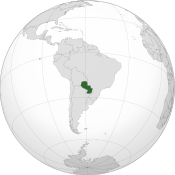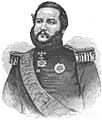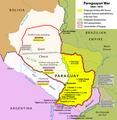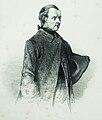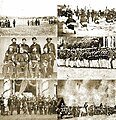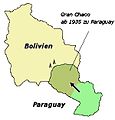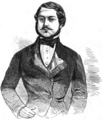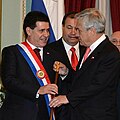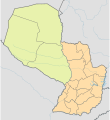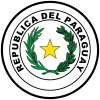Portal:Paraguay
The Paraguay Portal
Paraguay (/ˈpærəɡwaɪ/; Spanish pronunciation: [paɾaˈɣwaj] ⓘ), officially the Republic of Paraguay (Spanish: República del Paraguay; Guarani: Paraguái Tavakuairetã), is a landlocked country in South America. It is bordered by Argentina to the south and southwest, Brazil to the east and northeast, and Bolivia to the northwest. It has a population of around 6.1 million, nearly 2.3 million of whom live in the capital and largest city of Asunción, and its surrounding metro area. Spanish conquistadores arrived in 1524, and in 1537 established the city of Asunción, the first capital of the Governorate of the Río de la Plata. During the 17th century, Paraguay was the center of Jesuit missions, where the native Guaraní people were converted to Christianity and introduced to European culture. After the expulsion of the Jesuits from Spanish territories in 1767, Paraguay increasingly became a peripheral colony. Following independence from Spain in the early 19th century, Paraguay was ruled by a series of authoritarian governments. This period ended with the disastrous Paraguayan War (1864–1870), during which the country lost half its prewar population and around 25–33% of its territory. In the 20th century, Paraguay faced another major international conflict—the Chaco War (1932–1935) against Bolivia—in which Paraguay prevailed. The country came under a succession of military dictators, culminating in the 35 year regime of Alfredo Stroessner, which lasted until his overthrow in 1989 by an internal military coup. This marked the beginning of Paraguay's current democratic era. Paraguay is a developing country, ranking 105th in the Human Development Index. It is a founding member of Mercosur, the United Nations, the Organization of American States, the Non-Aligned Movement and the Lima Group. Additionally, the city of Luque, in metropolitan Asuncion, is the seat of the South American Football Confederation. Although one of only two landlocked countries in South America (Bolivia is the other), Paraguay has ports on the Paraguay and Paraná rivers that give exit to the Atlantic Ocean, through the Paraná-Paraguay Waterway. The majority of Paraguay's 6 million people are mestizo, and Guarani culture remains widely influential; more than 90% of the population speak various dialects of the Guarani language alongside Spanish. Paraguay's GDP per capita PPP is the seventh in South America. In a 2017 Positive Experience Index based on global polling data, Paraguay ranked as the "world's happiest place". (Full article...) Selected article - Reductions (Spanish: reducciones, also called congregaciones; Portuguese: redução, pl. reduções) were settlements established by Spanish rulers and Roman Catholic missionaries in Spanish America and the Spanish East Indies (the Philippines). In Portuguese-speaking Latin America, such reductions were also called aldeias. The Spanish and Portuguese relocated, forcibly in many cases, indigenous inhabitants (Indians or Indios) of their colonies into urban settlements modeled on those in Spain and Portugal. The Royal Academy of Spain defines reducción (reduction) as "a grouping into settlement of indigenous people for the purpose of evangelization and assimilation." In colonial Mexico, reductions were called "congregations" (congregaciones). Forced resettlements aimed to concentrate indigenous people into communities, facilitating civil and religious control over populations. The concentration of the indigenous peoples into towns facilitated the organization and exploitation of their labor. The practice began during Spanish colonization in the Caribbean, relocating populations to be closer to Spanish settlements, often at a distance from their home territories, and likely facilitated the spread of disease. Reductions could be either religious, established and administered by an order of the Roman Catholic church (especially the Jesuits), or secular, under the control of Spanish or Portuguese governmental authorities. The best known, and most successful, of the religious reductions were those developed by the Jesuits in Paraguay and neighboring areas in the 17th century. The largest and most enduring secular reductions were those imposed on the highland people of the former Inca Empire of Peru during the rule of Viceroy Francisco de Toledo (1569–1581). During the early stages of Christianisation of the Americas, Spanish Catholic authorities might establish ecclesiastical missionary proto-parish subdivisions - Spanish: doctrinas; singular: Spanish: doctrina, lit. 'doctrine' – for the indoctrination of the faith. (Full article...)CategoriesGeneral imagesThe following are images from various Paraguay-related articles on Wikipedia.
Did you know?WikiProjectsThings to doRelated portalsWikimediaThe following Wikimedia Foundation sister projects provide more on this subject:
| ||||



